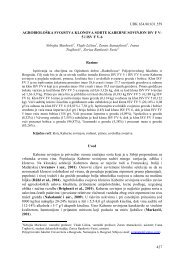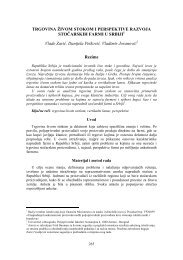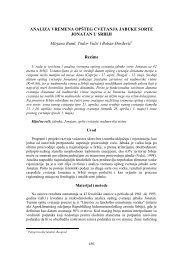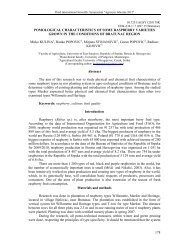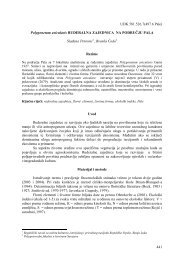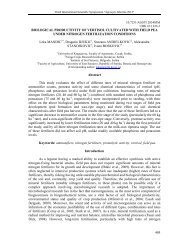forage quality as a part of a modern concept of ruminant nutrition
forage quality as a part of a modern concept of ruminant nutrition
forage quality as a part of a modern concept of ruminant nutrition
Create successful ePaper yourself
Turn your PDF publications into a flip-book with our unique Google optimized e-Paper software.
ZaključakKvalitet voluminoznog dela obroka je od velikog značaja za efik<strong>as</strong>nost proizvodnjemesa i mleka u govedarstvu i ovčarstvu. Savremeni koncepti ishrane preživara baziraju se naupotrebi konzervisane voluminozne hrane (minimalnih količina sena i maksimalnih količin<strong>as</strong>ilaže). U tehnologiji siliranja kukuruza i lucerke dan<strong>as</strong> dominira upotreba bioloških dodatakakoja ima za cilj maksimalnu očuvanost hranljive vrednosti. Budući pravci razvoja ovetehnologije imaće za cilj povećanje proteinske vrednosti kukuruzne silaže i smanjenjedegradacije proteina u lucerkinoj senažiZahvalnostZahvaljujemo se Ministarstvu prosvete i nauke Republike Srbije koje je finansiraloovaj rad sredstvima projekta III-46012.LiteraturaBal, M. A., Shaver, R. D., Shinners, K. J., Coors, J. G., Lauer, J. G., Straub, R. J., Koegel, R.G. (2000): Stage <strong>of</strong> maturity, processing, and hybrid effect on ruminal in situdisappearance <strong>of</strong> whole–plant corn silage. Animal feed science and technology, 86: 83-94.Bolsen, K. (1993): Effect <strong>of</strong> Alfa-Save treatment on dry matter digestibility and voluntaryintake <strong>of</strong> alfalfa hay. Poster presentation at Alltech’s 9th annual symposium onbiotechnology in the feed industry, April, Lexington, Ky.Broderick, G. A., Albrecht; K. A., Owens, V. N., Smith, R. R. (2004): Genetic variation inred clover for rumen protein degradability. Animal feed science and technology, 113, 157–167.Dinić, B., Đorđević, N., Ignjatović, S., Sokolović, D. (2004): Savremeni trendovi utehnologiji siliranja. X simpozijum o krmnom bilju Srbije i Crne Gore sa međunarodnimučešćem. Acta Agriculturae Serbica, 9, 17: 553-564.Đorđević, N., Koljajić. V., Pavličević. A. (1995): Putevi poboljšanja kvaliteta kab<strong>as</strong>te hrane.XVI republičko savetovanje ,,Proizvodnja mleka i meda“, 8. i 9. jun 1995., BanjaKoviljača. Zbornik radova, 14-29.Đorđević, N., Koljajić, V., Grubić, G. (1999): Influence <strong>of</strong> sulphuric acid <strong>as</strong> conservative onproteolysis <strong>of</strong> lucerne and red clover silage. 5th International Symposium ,,New trends inbreeding farm animals“. Biotechnology in Animal Husbandry, 15, 5-6: 287-297.Đorđević, N., Dinić B., Grubić, G., Glamočić, D., Stojanović, B. (2004a): Savremenipostupci u tehnologiji siliranja lucerke. Mlekarstvo, 3, 32: 1055-1062.Đorđević, N., Dinić, B., Grubić, G., Koljajić, V. Dujić, D. (2004b): Kontrola proteolitičkihprocesa u siliranoj hrani. X simpozijum o krmnom bilju Srbije i Crne Gore sameđunarodnim učešćem.Acta Agriculturae Serbica, 9, 17: 565-572.Đorđević, N., Grubić, G., Radivojević, M., Stojanović, B., Adamović, O. (2005): Ishranakrava obrocima na bazi različitih vrsta silaže. XIX savetovanje agronoma, veterinara itehnologa, 16-17.02.2005, Padinska Sakela. Zbornik naučnih radova, 11, 3-4: 65-73.Đorđević, N., Grubić, G., Adamović, M., Nježić, D., Nježić, A., Stojanović, B. (2006): Theinfluence <strong>of</strong> addition <strong>of</strong> zenural 70, urea and min-a-zel plus on chemical composition and<strong>quality</strong> <strong>of</strong> whole maize plant silage. Journal <strong>of</strong> Agricultural Sciences. 51, 1: 71-78.Đorđević, N., Grubić, G., Dinić, B., Glamočić, D., Stojanović, B. (2007): Kvalitet hrane zaživotinje u svetlu starih i novih propisa. 1. Međunarodna konferencija o dobrobiti i222
iosigurnosti na farmama u Srbiji. Poljoprivredni fakultet, Zemun, 14. i 15. novembar2007. Monografija, 321-328.Đorđević, N., Makević, M., Grubić, G., Jokić, Ž. (2009): Ishrana domaćih i gajenih životinja.Univerzitet u Beogradu, Poljoprivredni fakultet.Đorđević, N., Grubić, G., Dinić, B., Lević, J., Stojanović, B., Božičković, A. (2010a): Animalfeed <strong>quality</strong> – p<strong>as</strong>t and present. XII international Symposium on Forage Crops <strong>of</strong>Republika <strong>of</strong> Serbia - Forage Crops B<strong>as</strong>is <strong>of</strong> the Sustainable Animal HusbandryDevelopment. Biotechnology in Animal Husbandry, 26, 1: 249-260.Đorđević, N., Grubić, G., Lević, J., Sredanović, S., Stojanović, B., Božičković, A., Lojanica,M. (2010b): The influence <strong>of</strong> various factors on the degree <strong>of</strong> nitrogen matter changes inlegume silages. 14. International Symposium Feed Technology, Institute for FoodTechnology, University <strong>of</strong> Novi Sad, International Feed Industry Federation IFIF. NoviSad, 19-21 October, 2010. Proceedings, 215-221.Đorđević, N., Grubić, G., Stojanović, B. (2010c): Savremeni principi ishrane životinja(plenarno predavanje). Prvi naučni simpozijum agronoma sa međunarodnim učešćemAGROSYM, Jahorina, hotel „Bistrica“, 09-11.12.2001. Zbornik radova, 30-46.Đorđević, N., Dinić, B. (2011): Proizvodnja smeša koncentrata za životinje (monografija).Institut za krmno bilje Kruševac.Đorđević, N., Grubić, G., Stojanović, B., Božičković, A., Ivetić, A. (2011): Savremenetehnologije siliranja kukuruza i lucerke. XXV savetovanje agronoma, veterinara itehnologa, 23-24.02.2011, Institut PKB Agroekonomik, Beograd. Zbornik naučnih radova,17, 3-4: 27-35.Forouzmand, M. A., Ghorbani, G. R., Alikhani, M. (2005): Influence <strong>of</strong> hybrid and maturityon the <strong>nutrition</strong>al value <strong>of</strong> corn silage for lactating dairy cows. 1: Intake, milk productionand component yield. Pakistan journal <strong>of</strong> <strong>nutrition</strong>, 4, 6: 435-441.Getachew, G., Dandekar, A. M., Pittr<strong>of</strong>f, W., De Peters, E. J., Putnam, D, H., Goyal, S.,Teuber, L., Uratsu, S. (2009): Impacts <strong>of</strong> polyphenol oxid<strong>as</strong>e enzyme expression intransgenic alfalfa on in vitro g<strong>as</strong> production and ruminal degradation <strong>of</strong> protein, andnitrogen rele<strong>as</strong>e during ensiling. Animal feed science and technology, 151, 44–54.Grubić, G., Đorđević, N., Radivojević, M. (1999): Fizičke osobine vlakana u obrocima zakrave. Arhiv za poljoprivredne nauke, 60, 210, 1-2: 61-72.Grubić, G., Adamović, M., Đorđević, N., Stojanović, B. (2002): Novi normativi za ishranumuznih krava. Mlekarstvo, 2: 37-42.Hu, W., Schmidt, R. J., McDonell, E. E., Klingerman, C. M., Kung, L. (2009): The effect <strong>of</strong>Lactobacillus buchneri 40788 or Lactobacillus plantarum MTD-1 on the fermentation andaerobic stability <strong>of</strong> corn silages ensiled at two dry matter contents. Journal <strong>of</strong> DairyScience, 92: 3907–3914Oude Elferink, S. J. W. H., Krooneman, J., Gottschal, J. C., Spoelstra, S. F., Faber, F.,Driehuis, F. (2001): Anaerobic conversion <strong>of</strong> lactic acid to acetic acid and 1,2-propanediolby Lactobacillus buchneri. Appl. Environ. Microbiol, 67:125–132Ranjit, N. K., Kung, L. (2000): The effect <strong>of</strong> Lactobacillus buchnery, Lactobacillusplantarum, or chemical preservative on the fermentation and aerobic stability <strong>of</strong> cornsilage. Journal <strong>of</strong> Dairi Science, 83: 526-535.Savoie, P., Tremblay, D., Lajoie, R., Roberge, M., Lemay, S. P. (1997): Forage macerationon a self-propelled mower: Effect <strong>of</strong> winrow deposition and inversion. Proceedings <strong>of</strong> theXVIII international gr<strong>as</strong>sland congress, Winnipeg, Manitoba, S<strong>as</strong>katoon, S<strong>as</strong>katchewan,Canada, 14,5-14,6.Slottner, D., Bertilsson, J. (2006): Effect <strong>of</strong> ensiling technology on protein degradation duringensilage. Animal feed science and technology, 127, 101–111.223
Stojanović, B., Grubić, G., Đorđević, N., Božičković, A., Ivetić, A. (2010): Physicallyeffective fibre in dairy cows <strong>nutrition</strong> and methods for determination. XII internationalSymposium on Forage Crops <strong>of</strong> Republika <strong>of</strong> Serbia - Forage Crops B<strong>as</strong>is <strong>of</strong> theSustainable Animal Husbandry Development. Biotechnology in husbandry, 26, 2: 457-467.Wilkinson, J. M., Toivonen, M. I. (2003): World silage-a survey <strong>of</strong> <strong>forage</strong> conservationaround the world. School <strong>of</strong> Biology, Universiti <strong>of</strong> Leeds, Leeds, LS2 9JT, UnitedKingdom.224
FORAGE QUALITY AS A PART OF A MODERNCONCEPT OF RUMINANT NUTRITION Nenad Đorđević 1 , Goran Grubić 1 , Bora Dinić 2 , Bojan Stojanović 1 , Aleksa Božičković 1SummaryThe b<strong>as</strong>ic <strong>concept</strong> <strong>of</strong> <strong>modern</strong> <strong>ruminant</strong> <strong>nutrition</strong> and the importance <strong>of</strong> <strong>forage</strong> <strong>quality</strong> (hay andsilage) for high, stabile and economic production <strong>of</strong> meat and milk in cattle and sheep production w<strong>as</strong>explained in the paper. The b<strong>as</strong>ic parameters <strong>of</strong> feedstuff <strong>quality</strong> are chemical composition, sensorycharacteristics and its safety for animal health.Hay and silage are main forms <strong>of</strong> conserved <strong>forage</strong>s. The influence <strong>of</strong> weather condition <strong>of</strong>hay <strong>quality</strong> is the re<strong>as</strong>on why hay h<strong>as</strong> most variable chemical composition and nutritive value.Because <strong>of</strong> that in the <strong>modern</strong> cattle production hay is used in very small amounts, which is necessaryto obtain rumination, and the ensiled feeds are used <strong>as</strong> much <strong>as</strong> possible. The use <strong>of</strong> conservedfeedstuffs with maximal <strong>quality</strong> is enabling cheaper production, better health and fertility anddecre<strong>as</strong>ed use <strong>of</strong> concentrates. In the ensiling technology the main emph<strong>as</strong>is today is in the selection<strong>of</strong> maize hybrids and legume selection to stimulate ruminal digestion, and genetic manipulations todecre<strong>as</strong>e proteolysis. The use <strong>of</strong> <strong>modern</strong> additives to improve aerobic stability <strong>of</strong> silages is enablingits use during the whole year, independently <strong>of</strong> the se<strong>as</strong>on, silo type, the way <strong>of</strong> silage extracting andother factors.Key words: hay, silage, <strong>quality</strong>, diet, milk, meat. Review paper1 Nenad Đorđević, PhD, pr<strong>of</strong>essor, Goran Grubić, PhD, pr<strong>of</strong>essor, Bojan Stojanović, PhD, <strong>as</strong>sistant pr<strong>of</strong>essor,Aleksa Božičković, dipl. ing, <strong>as</strong>sistant, University <strong>of</strong> Belgrade, Faculty <strong>of</strong> Agriculture, Nemanjina 6, 11080Zemun, Serbia;2 Bora Dinić, PhD, Scientific counsellor, Institute for Forage Crops, Globoder, 37251 Kruševac, Serbia.225




